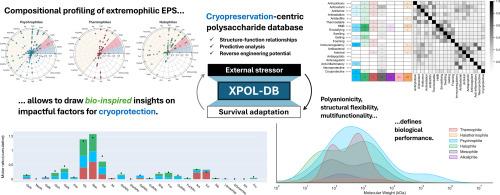低温保存中的多糖:嗜极特性和选择压力在结构-功能关系中的作用的多维系统综述
IF 12.5
1区 化学
Q1 CHEMISTRY, APPLIED
引用次数: 0
摘要
生物物质的低温保存已经积累了最高的生物医学兴趣,因为它有可能延长生物物质在假死状态下的保质期。在自然界中,嗜极微生物具有出色的生存能力,在极端寒冷、高温、盐度和酸度的环境中生存。通过达尔文的选择适应,它们已经发展出生化防御策略来对抗致命的刺激。在此,我们建立了一个嗜极性EPS结构-功能关系数据库(XPOL-DB),该数据库汇总了145个嗜极性和中温性EPS的生化报告,共128个生化报告,并建立了嗜冷性EPS的化学图谱。总的来说,与线性、刚性、中性的亲热性EPS相比,亲湿性EPS是高支化、聚阴离子、细长结构,具有更高的柔韧性和分子量(16 - 300 MDa),主要表达极性单体(GalNAc、GalA、GlcNAc、GlcA)。嗜冷菌和嗜盐菌之间EPS的显著相似性表明,冰生长和极端盐度根植于一个共同的物理膜不稳定机制,在这个机制中,相似的化学特性可以二元地赋予抗冻性和耐盐性。嗜冷菌是研究极端寒冷如何选择低温生物EPS适应的令人兴奋的试验台;并且可以推动逆向工程的努力,以设计最佳的生物基,无细胞毒性的冷冻保护剂多糖。本文章由计算机程序翻译,如有差异,请以英文原文为准。

Polysaccharides in cryopreservation: multidimensional systematic review of extremophilic traits and the role of selective pressure in structure-function relationships
Cryopreservation of biological matter has accumulated apex biomedical interest for its potential in elongating the shelf-life of biological matter in a state of suspended animation. In Nature, extremophilic microorganisms have an outstanding ability of surviving in habitats where extreme cold, heat, salinity and acidity defy the established boundaries for life. Through Darwinian selective adaptation, they have developed biochemical defense strategies to counteract lethal stimuli. Here, we have compiled an extremophilic EPS structure-function relationship database (XPOL-DB) which aggregates reports on 145 extremophilic and mesophilic EPS, for a total of 128 biochemical and establishes the psychrophilic chemical profile for cold adaptation. Overall, psychrophilic EPS are highly-branched, polyanionic, elongated structures of increased flexibility and molecular weight (16 − 300 MDa), with predominant expression of polar monomers (GalNAc, GalA, GlcNAc, GlcA) – compared to the linear, rigid, neutral thermophilic EPS. The significant EPS similarity between psychrophiles and halophiles suggests ice growth and extreme salinity are rooted in a shared mechanism of physical membrane destabilization, for which similar chemical traits can dualistically imbue freeze tolerance and salt tolerance. Psychrophiles are exciting testbeds for the mapping of how extreme cold selects for cryobiological EPS adaptation; and can fuel reverse engineering efforts to design optimal bio-based, non-cytotoxic cryoprotectant polysaccharides.
求助全文
通过发布文献求助,成功后即可免费获取论文全文。
去求助
来源期刊

Carbohydrate Polymers
化学-高分子科学
CiteScore
22.40
自引率
8.00%
发文量
1286
审稿时长
47 days
期刊介绍:
Carbohydrate Polymers stands as a prominent journal in the glycoscience field, dedicated to exploring and harnessing the potential of polysaccharides with applications spanning bioenergy, bioplastics, biomaterials, biorefining, chemistry, drug delivery, food, health, nanotechnology, packaging, paper, pharmaceuticals, medicine, oil recovery, textiles, tissue engineering, wood, and various aspects of glycoscience.
The journal emphasizes the central role of well-characterized carbohydrate polymers, highlighting their significance as the primary focus rather than a peripheral topic. Each paper must prominently feature at least one named carbohydrate polymer, evident in both citation and title, with a commitment to innovative research that advances scientific knowledge.
 求助内容:
求助内容: 应助结果提醒方式:
应助结果提醒方式:


